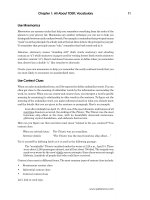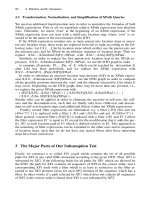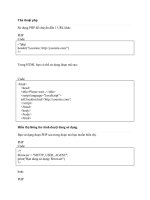Tài liệu Timing and Delay part 3 doc
Bạn đang xem bản rút gọn của tài liệu. Xem và tải ngay bản đầy đủ của tài liệu tại đây (16.6 KB, 5 trang )
[ Team LiB ]
10.3 Timing Checks
In the earlier sections of this chapter, we discussed how to specify path
delays. The purpose of specifying path delays is to simulate the timing of the
actual digital circuit with greater accuracy than gate delays. In this section,
we describe how to set up timing checks to see if any timing constraints are
violated during simulation. Timing verification is particularly important for
timing critical, high-speed sequential circuits such as microprocessors.
System tasks are provided to do timing checks in Verilog. There are many
timing check system tasks available in Verilog. We will discuss the three
most common timing checks
[1]
tasks: $setup, $hold, and $width. All timing
checks must be inside the specify blocks only. Optional notifier arguments
used in these timing check system tasks are omitted to simplify the
discussion.
[1]
The IEEE Standard Verilog Hardware Description Language document
provides additional constraint checks, $removal, $recrem, $timeskew,
$fullskew. Please refer to it for details. Negative input timing constraints can
also be specified.
10.3.1 $setup and $hold Checks
$setup and $hold tasks are used to check the setup and hold constraints for a
sequential element in the design. In a sequential element such as an edge-
triggered flip-flop, the setup time is the minimum time the data must arrive
before the active clock edge. The hold time is the minimum time the data
cannot change after the active clock edge. Setup and hold times are shown in
Figure 10-6
.
Figure 10-6. Setup and Hold Times
$setup task
Setup checks can be specified with the system task $setup.
Usage: $setup(data_event, reference_event, limit);
data_event Signal that is monitored for violations
reference_event Signal that establishes a reference for monitoring
the data_event signal
limit Minimum time required for setup of data event
Violation is reported if (T
reference event
- T
data event
) < limit.
An example of a setup check is shown below.
//Setup check is set.
//clock is the reference
//data is being checked for violations
//Violation reported if T
posedge_clk
- T
data
< 3
specify
$setup(data, posedge clock, 3);
endspecify
$hold task
Hold checks can be specified with the system task $hold.
Usage: $hold (reference_event, data_event, limit);
reference_event Signal that establishes a reference for monitoring
the data_event signal
data_event Signal that is monitored for violation
limit Minimum time required for hold of data event
Violation is reported if ( T
data event
- T
reference event
) < limit.
An example of a hold check is shown below.
//Hold check is set.
//clock is the reference
//data is being checked for violations
//Violation reported if T
data
- T
posedge_clk
< 5
specify
$hold(posedge clear, data, 5);
endspecify
10.3.2 $width Check
Sometimes it is necessary to check the width of a pulse.
The system task $width is used to check that the width of a pulse meets the
minimum width requirement.
Usage: $width(reference_event, limit);
reference_event Edge-triggered event (edge transition of a signal)
limit Minimum width of the pulse
The data_event is not specified explicitly for $width but is derived as the next
opposite edge of the reference_event signal. Thus, the $width task checks the
time between the transition of a signal value to the next opposite transition in
the signal value.
Violation is reported if ( T
data_event
- T
reference_event
) < limit.
//width check is set.
//posedge of clear is the reference_event
//the next negedge of clear is the data_event
//Violation reported if T
data
- T
clk
< 6
specify
$width(posedge clock, 6);
endspecify
[ Team LiB ]
[ Team LiB ]
10.4 Delay Back-Annotation
Delay back-annotation is an important and vast topic in timing simulation.
An entire book could be devoted to that subject. However, in this section, we
introduce the designer to the concept of back-annotation of delays in a
simulation. Detailed coverage of this topic is outside the scope of this book.
For details, refer to the IEEE Standard Verilog Hardware Description
Language document.
The various steps in the flow that use delay back-annotation are as follows:
1. The designer writes the RTL description and then performs functional
simulation.
2. The RTL description is converted to a gate-level netlist by a logic
synthesis tool.
3. The designer obtains pre-layout estimates of delays in the chip by using
a delay calculator and information about the IC fabrication process.
Then, the designer does timing simulation or static timing verification
of the gate-level netlist, using these preliminary values to check that the
gate-level netlist meets timing constraints.
4. The gate-level netlist is then converted to layout by a place and route
tool. The post-layout delay values are computed from the resistance (R)
and capacitance (C) information in the layout. The R and C information
is extracted from factors such as geometry and IC fabrication process.
5. The post-layout delay values are back-annotated to modify the delay
estimates for the gate-level netlist. Timing simulation or static timing
verification is run again on the gate-level netlist to check if timing
constraints are still satisfied.
6. If design changes are required to meet the timing constraints, the
designer has to go back to the RTL level, optimize the design for
timing, and then repeat Step 2 through Step 5.
Figure 10-7 shows the flow of delay back annotation.
Figure 10-7. Delay Back-Annotation
A standard format called the Standard Delay Format (SDF) is popularly used
for back-annotation. Details of delay back-annotation are outside the scope of
this book and can be obtained from the IEEE Standard Verilog Hardware
Description Language document.
[ Team LiB ]









